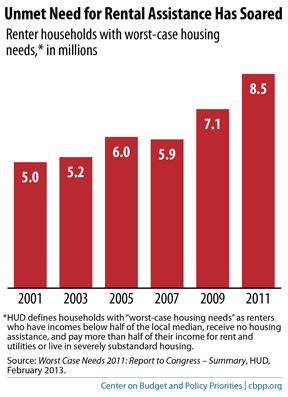BEYOND THE NUMBERS
Hardship in America, 2013: Homelessness Remains High and Affordable Housing Is Increasingly Scarce
Six years after the Great Recession began, the number of homeless families with children remains stubbornly high. And the number of low-income households with unmet needs for housing assistance — especially families with children — has soared. Funding cuts under sequestration threaten to halt progress against homelessness and worsen the shortage of affordable housing.
Let’s first look at the homelessness data:
- Over 1.1 million children and youth were homeless during the 2011-2012 school year, according to the Department of Education. Four-fifths were living in homes that were not their own and that may be crowded and unstable; the rest were living in homeless shelters or on the street, in cars, or in abandoned buildings.
- The number of families with children in homeless shelters or temporary housing for the homeless jumped by 30 percent in the first two years of the recession (2007-2009) and remained only slightly below the 2009 level as of 2012, according to a Department of Housing and Urban Development (HUD) report. This figure doesn’t include families who are doubling up with other households, even if they have to move every few weeks.
- HUD’s latest count of the number of people living on the streets or in shelters on one night in January showed a modest drop among families with children. (The drop since 2007, however, was close to 25 percent each among people with disabilities and veterans.) And one-night counts are less reliable than counts of the number of homeless households over a whole year.

More than 2 million low-income households use vouchers to rent modest private-market housing at an affordable cost. But low-income seniors, people with disabilities, and working families with children eligible for the voucher program often must wait years for assistance due to limited funding.
Sequestration is hitting both the voucher program and anti-homelessness efforts (as well as public housing and other areas). Scheduled cuts in voucher funding could eliminate vouchers for as many as 185,000 low-income families by the end of 2014. Cuts in the grants that communities use to help homeless people could force them to cut back efforts to prevent homelessness or re-house homeless families. The voucher cuts also mean that many fewer families that are homeless or at imminent risk of homelessness will have access to vouchers.
Sequestration’s harmful impact on low-income housing is one of many reasons why budget negotiators should replace part or all of sequestration for the next year or two with alternative deficit-reduction measures.
